Select Language
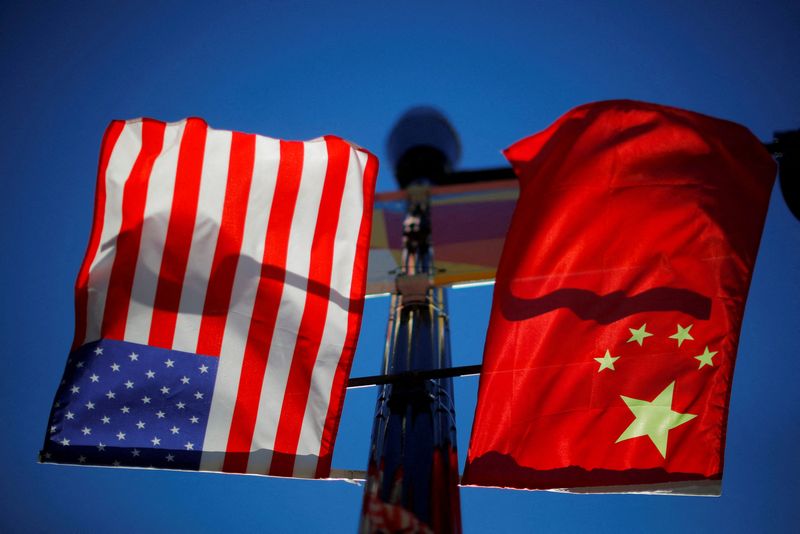
By Idrees Ali, Alexandra Alper and Michael Martina
WASHINGTON (Reuters) -The United States on Wednesday added more than a dozen Chinese companies to a list created by the Defense Department to highlight firms it says are allegedly working with Beijing's military, as part of a broader effort to keep American technology from aiding China.
New additions to the list, first reported by Reuters, were posted on the Department of Defense website and include memory chip maker YMTC, artificial intelligence company Megvii, lidar maker Hesai Technology and tech company NetPosa.
Amid strained ties between the world's two biggest economies, the updated list is one of numerous actions Washington has taken in recent years to highlight and restrict Chinese companies that is says may strengthen Beijing's military.
A spokesperson for the Chinese embassy in Washington said China opposed the move and called it an abuse of state power, adding that it ran counter to the U.S.'s "alleged commitment to market competition and international fair trade."
Hesai Group said it does not sell products to any military in any country and it does not have ties with any military. The company said it was disappointed to be added to the list.
YMTC, and Megvii did not immediately respond to requests for comment.
While being placed on the list doesn't involve immediate bans, it can be a blow to designated companies' reputations and represents a stark warning to U.S. entities and companies about the risks of conducting business with them. It could also add pressure on the Treasury Department to sanction the companies.
In addition, the 2024 National Defense Authorization Act added some teeth to the "Section 1260H" list, prohibiting the Defense Department under Section 805 of the law in coming years from contracting with any of the designated companies.
"The Defense Department's updated 1260H list underscores China's unwavering commitment to its military-civil fusion strategy," said Craig Singleton, a senior fellow at the Foundation for Defense of Democracies.
"Being listed on 1260H poses major reputational risks to Chinese companies," he added, noting that some Chinese firms have tried to be removed from the list.
Other firms added on Wednesday include China Three Gorges Corp, China Construction Technology Co and Yitu Network Technology, as well as publicly traded companies Chengdu JOUAV Automation Tech Co, Chengdu M&S Electronics Technology Co, Guizhou Aviation Technical Development Co, and ShenZhen Consys Science & Technology Co.
They join previously listed aviation company AVIC, BGI Genomics Co, China Mobile (NYSE:CHL), energy company CNOOC (NYSE:CEO) and China Railway Construction Corp.
Separately on Wednesday, senior U.S. officials, including FBI Director Christopher Wray, warned that hackers linked to China's government are preparing to cause "real-world harm" by targeting critical U.S. infrastructure, such as water treatment plants, the electric grid, oil and natural gas pipelines, and transportation hubs.
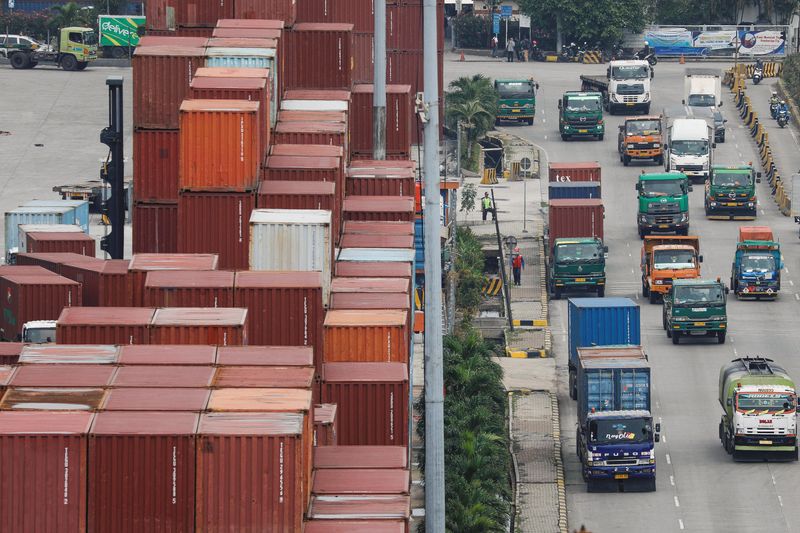
By Veronica Dudei Maia Khongwir
BENGALURU (Reuters) - Indonesia's economy grew 5.0% in the fourth quarter from a year earlier, supported by resilient domestic consumption, despite exports shrinking and commodity prices falling, a Reuters poll of 23 economists found.
Growth in Southeast Asia's largest economy was mostly driven by private consumption which remains strong against a cumulative 250 basis points of interest rate hikes by Bank Indonesia since August 2022.
The poll median for 5.00% growth last quarter from the previous year was slightly faster than the 4.94% expansion in the preceding quarter. The latest data will be released on Feb. 5.
On a quarter-on-quarter basis, the economy grew 0.41% in the October-December period, according to a smaller sample in the Jan. 25-31 Reuters poll.
"The current policy rate is not tight enough to hinder economic growth because consumer appetite to withdraw loans remains robust and we saw good performance in terms of consumption, working capital and investment", said Irman Faiz, an economist at Bank Danamon.
"Bank Indonesia is on the same page with us, they are seeing resilient growth last year, despite the global economic slowdown and export contraction."
The resource-rich country recently reported a fall in its 2023 trade surplus as exports and imports dropped amid falling commodity prices.
Furthermore, weak demand from China, Indonesia's biggest trading partner, adds more pressure on its exports.
"Monthly exports and imports fell in year-on-year terms throughout the last quarter, the former being hit by weaker demand from China and other major export partners," said Jeemin Bang, an associate economist at Moody's (NYSE:MCO) Analytics.
"Indonesia's economic expansion has been relatively stable in recent years, and we expect this to continue. Moreover, consumption growth will moderate from here, with the post-pandemic recovery largely run its course."
The economy was forecast to have grown 5.0% in 2023 - within Bank Indonesia's estimate of 4.5% to 5.3% - and will do so at the same pace this year, a separate Reuters survey showed.
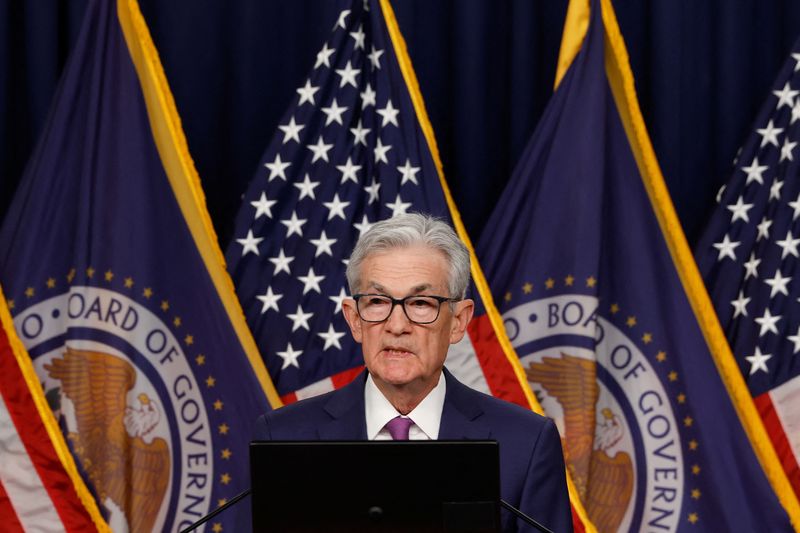
By Michael S. Derby
NEW YORK (Reuters) - U.S. Federal Reserve Chair Jerome Powell said on Wednesday that officials have begun discussing what it would take for them to stop the ongoing run-off of the central bank's balance sheet.
Balance sheet run-off "has gone very well," Powell said at his press conference following the latest rate-setting Federal Open Market Committee meeting. He was referring to a process known as quantitative tightening, or QT, which involves the Fed allowing its holdings of cash and bonds to contract by way of allowing Treasury and mortgage bonds it owns to mature and not be replaced.
QT, which has seen the Fed shrink its holdings by over $1.3 trillion to $7.7 trillion, has run independently from the Fed's rate hike cycle but nevertheless complements it. And with rate cuts standing as the Fed's next likely move, many in markets have been expecting the central bank to wind down QT this year as well.
"We're getting to that time where questions are beginning to come into greater focus about the pace of run-off and all that," Powell said. "So at this meeting, we did have some discussion of the balance sheet, and we're planning to begin in-depth discussions of balance sheet issues at our next meeting in March."
The pace of debate pointed to by Powell suggests the QT effort could be in play for longer than many top Wall Street analysts had been expecting.
Going into this week's FOMC meeting, signs of a rapid pull-back in key measures of market liquidity had driven a number of analysts to argue the Fed would lay out the start of a formal plan to shutter the QT effort at the March meeting. Some even saw QT ending by summer.
The Fed is widely expected to slow at some point the speed at which it allows Treasury securities to run off the balance sheet, reducing the current cap of $60 billion. As the Fed wants to get back to an all government bond portfolio and has struggled to reach the $35 billion per month cap on the mortgage bond run-off, many expect the Fed to allow that type of contraction to continue even after QT ends.
Slowing the rundown is a prelude to stopping QT altogether, but some have argued that an earlier slowdown of QT could give the Fed more space to run the effort for longer. The Fed is trying to strip the market of excessive liquidity added in the response to the pandemic, and doesn't want to push QT too far lest it destabilize money market rates.
Many have looked to the Fed's reverse repo facility as a proxy for excessive liquidity and have argued that facility, which peaked at about $2.6 trillion on the final trading day of 2022 and was at $615.4 billion on Wednesday, will likely fall to zero before QT can stop. But Powell suggested that might not be right.
The correct level for the reverse repo facility is "not a decision that we've made," Powell said, adding "we wouldn't be taking a position it's got to go to zero."
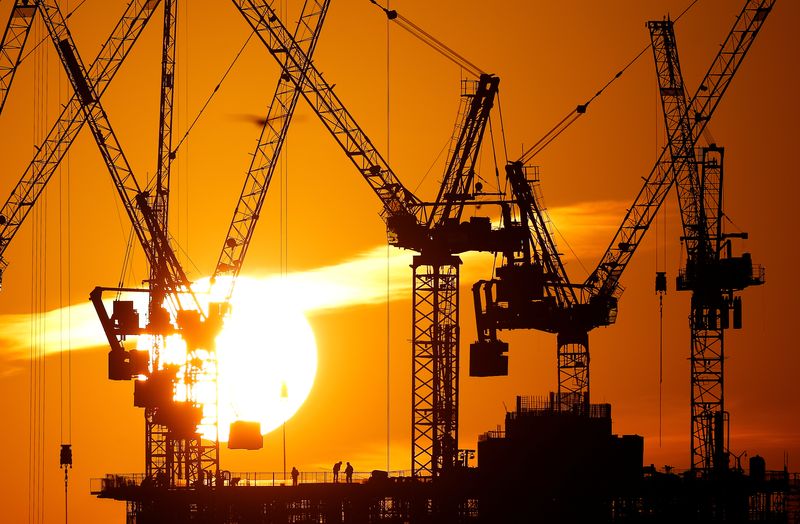
LONDON(Reuters) - Confidence in Britain's construction sector rose marginally in late 2023, helped by the prospect of interest rate cuts, according to a survey published before the Bank of England is expected to hold rates at their highest level since 2008.
The Royal Institution of Chartered Surveyors (RICS) said the outlook for the year ahead was more upbeat, with its headline workloads measure climbing to 12% from 6%.
It said that a net balance of 8% of survey respondents reported a fall in activity in the three months to December, less downbeat than the 10% reporting a decline in the three months before.
"While the UK's construction sector remained fairly subdued at the tail end of 2023, belief in a rate cut in 2024 appears to be supporting greater expectations for the future," the report said.
RICS said there was a "clear divergence" between sectors, with home-building contracting further while infrastructure activity continued to grow.
Despite some optimism spurred by lower mortgage rates, Britain's housing market has been slow to recover from the long run of interest rate increases by the BoE and the hit following the "mini-budget" crisis of late 2022.
The BoE is expected to leave interest rates on hold at a 15-year high of 5.25% later on Thursday and possibly signal a change in its rate stance after 14 back-to-back increases between December 2021 and August 2023.
Although pressures around skills shortages persisted in the fourth quarter, RICS said survey respondents were anticipating a rise in employment in the next 12 months.
"Supported by the prospect of easing interest rates later this year, overall workloads are anticipated to rise, with respondents anticipating this pick-up will be accompanied by a rise in employment levels across the industry," Tarrant Parsons (NYSE:PSN), senior economist at RICS said.
The most recent official data showed construction output fell 0.2% in November.
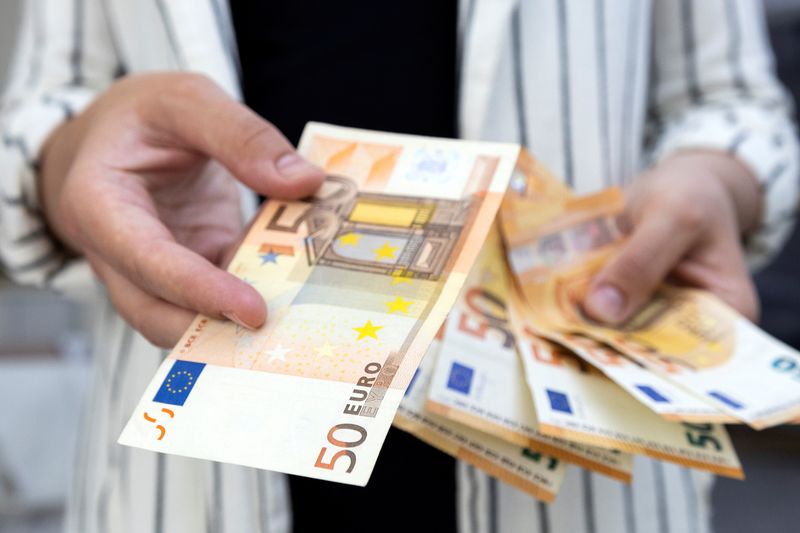
By Yoruk Bahceli and Harry Robertson
AMSTERDAM (Reuters) - Euro zone governments sold a record amount of bonds directly to investors in January, seeing the highest demand ever, as hopes grow for interest rate cuts to support a weakening economy.
This is in stark contrast to worries around high government funding needs in 2023, especially in the United States, which sparked a bond rout and pushed borrowing costs to their highest in over a decade in October.
Euro area states raised a record 73 billion euros ($79.1 billion) from syndicated bond sales in January, LSEG IFR data to Jan. 30 shows. Syndications are closely watched to gauge demand as governments sell bonds directly to investors. At an auction, bonds are first sold to banks.
Around 725 billion euros of demand exceeded that funding by a record 10 times, Reuters calculations using data from debt management offices and IFR show.
Data on Tuesday showed the euro zone economy stagnated last year. Money markets have priced in a first European Central Bank rate cut in April, boosting sentiment towards bonds.
The scale of demand at government bond sales in January surpassed that seen during the COVID-19 pandemic, when the ECB bought trillions of euros of debt to hold down borrowing costs.
"It was certainly somewhat of a surprise given the fact that everyone was talking about the wall of supply that was coming," said Belgium's debt agency director Maric Post.
Belgium saw a record 75 billion euros of demand for a 10-year bond on Jan. 9, raising 7 billion euros.
Another notable deal was Spain's, which saw the highest ever demand for an individual government bond at 138 billion euros and raised 15 billion euros from the 10-year debt sale, one of its two largest issuances in history.
Lee Cumbes, head of debt capital markets EMEA at Barclays, said that a year-end bond rally, when many investors had already closed their books, meant those who missed out were now readjusting positions by participating in the debt sales.
Belgium's Post added there was "probably an underestimation of the amount of money that was already waiting to be invested".
Bond markets posted their biggest two-month rally on record in November-December, rebounding from their earlier rout.
Some longer-term investors have put in larger orders for the deals than last year, Barclays's Cumbes noted.
OUT OF THE WOODS?
Many governments saw higher demand from investors outside the euro zone, BofA said, highlighting the potential for the bloc to draw back foreign investors as it leaves behind its negative rates era.
For all the worries around high funding needs, investors noted governments paid limited additional yield on outstanding bonds to lure buyers.
"Because of the strong demand... sovereigns have not had to offer an excess issuance premium to get their substantial issuance volumes away," said Roger Hallam, global head of rates at Vanguard, which manages $8.2 trillion in assets, favouring Spanish and Greek bonds.
With the euro area home to some of the world's largest government bond markets, the strong investor appetite is a good sign globally as near-record funding needs challenge borrowers.
As the ECB reduces its bond holdings, markets may have to absorb a record 675 billion euros of the bloc's debt, Barclays estimates.
U.S. Treasury yields fell on Monday after the government said it expects to borrow less during the first quarter than initially forecast. Monetary policy uncertainty in Japan has weakened demand for its bond sales.
Traders were cautious, noting that auctions, where governments sell most of their bonds, have not gone as well.
"That doesn't really resonate the same message (as the syndications)," said BofA's head of EMEA linear rates trading Kal El-Wahab.
He said that metrics such as the average cutoff price - the lowest price accepted for an auction - and the level of overbidding - how much higher the bonds price relative to those outstanding - are lower than last year's average.
With demand for bonds high, investors also warn that hedge funds, which only receive a small share of governments' debt sales, may be overstating their demand to get better allocations - a long-standing issue that skews demand figures.
Given uncertainty around elections and monetary policy this year, Barclays' Cumbes said he advised governments to get more of their funding done earlier.
"There's going to be a lot of activity, a lot of fundraising to do, a lot of countries competing for money," he added.
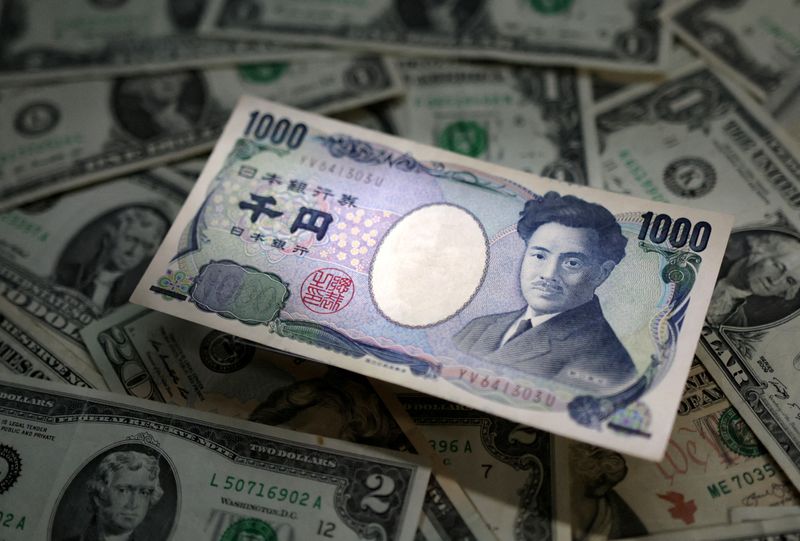
TOKYO (Reuters) - Japanese authorities are committed to a flexible exchange rate, which acts as a shock absorber and supports the Bank of Japan's monetary policy objective, a senior International Monetary Fund (IMF) official said on Wednesday.
"We've had very good discussions with Japanese authorities on exchange rate issues. Let me emphasize, I see no fundamental divergence in views between the Fund and Japanese authorities about exchange rate policies," Krishna Srinivasan, director of the IMF's Asia and Pacific Department, told a news conference.
"Japanese authorities are committed to a flexible exchange rate which acts as a shock absorber, and supports the monetary policy objective of price stability," Srinivasan said.

By Aftab Ahmed, Saurabh Sharma and Jatindra Dash
BAHBOLIYA MAHADA, India, (Reuters) - Jakir Khan, an Indian farm worker, says he has cut down on food as his income has halved. There are fewer and fewer opportunities, he says, for employment in his small village in Uttar Pradesh state.
Khan says his monthly income has come down to 5,000 Indian rupees ($60.17) from 10,000 Indian rupees before the pandemic, while his weekly expenses on food have gone up 60%. In November, he took a 100,000 rupees loan from relatives.
Khan, like millions of others, is struggling with the economic slowdown in rural India, home to 60% of its 1.4 billion people, which is painting a starkly different picture to the country's spectacular economic growth and the prosperity of its urban population.
Reuters interviewed nearly 50 families in rural areas such as Khan's in three Indian states - Uttar Pradesh, Odisha and West Bengal - and 85% of them reported stagnant or lower incomes compared to the years before the pandemic. They said inflation was high and was forcing them to borrow money to sustain already reduced consumption.
The families attributed the lower incomes to fewer jobs, more people vying for the same work leading to lesser pay and lower farm output, which reduces the demand for farm labour.
While there have been some indicative data points that show rural recovery has been slow, there is no recent, publicly available survey on incomes and consumption in India's vast rural hinterland.
"Who doesn't want to eat meat? But times are hard and I cannot afford it. I eat meat only in marriage functions of others," Khan said, speaking in Bahboliya Mahada, a village surrounded by sugarcane fields and banana plantations.
India's statistics office has forecast overall annual growth of 7.3%, the highest among major global economies, for the current fiscal year ending in March, fuelled by sectors like construction and financial services.
But growth in farm output, which contributes about 15% of GDP and employs more than 40% of the workforce, was seen slowing to 1.8% in the current fiscal year, from 4% a year ago.
"I am a bit concerned. A host of indicators is not painting a great picture," Dhiraj Nim, an economist at ANZ, told Reuters. These included an increase in seasonally adjusted demand for the government's minimum job guarantee scheme for rural areas, low agriculture growth in the September quarter and rising inflation in the hinterland, he said.
"Industries that tend to be more...rurally focused in terms of employment are also not doing well," he said.
Prime Minister Narendra Modi is seeking a third term in elections due by May this year, and economists say the government might have to spend more on rural subsidies to ease the distress.
Asked for comment, the government's economic policy body, NITI Aayog, said multi-dimensional poverty was estimated to have declined to 11.28% of the population from 29.17% between 2013-14 and 2022-23, or by around 250 million people.
"Of these (114.3 million) belong to Uttar Pradesh, West Bengal and Odisha, the states in which Reuters has conducted this survey," it said in a statement.
"The whole programme of Mr Modi's government has been about inclusion and inclusive growth," NITI Aayog vice chairman Suman Bery told reporters on a visit to Singapore earlier this month.
"To focus on short-term agricultural performance is to neglect all that has happened in providing a whole range of safety nets during COVID and after COVID," he added.
"There is a lot to be done on the structural side but I don't think one can reasonably argue that the overall programme has not been inclusive."
LOWER FARM INCOMES
The rural economy has been hurt by a drop in the output of some key crops, such as wheat, in the past three years due to a rise in temperatures, patchy monsoon rains and falling reservoir levels.
On top of that, higher food inflation has forced the government to ban exports of wheat, some grades of rice and onions to contain prices, but this has hurt farm incomes even more.
Over 44% of the families that Reuters interviewed said they were earning less than before the pandemic years, while about 41% reported the same income levels as before and the rest reported an increase in their incomes.
Brokerage house Motilal Oswal said rural non-agricultural wages have contracted for the second consecutive year, while agricultural wages grew just 0.2%, the lowest growth in 3 years.
It estimates rural spending fell 0.5% in the July-September period.
Arun Kumar, an economist and former professor at New Delhi's Jawaharlal Nehru University, said the gap in incomes between the mostly urban organised sector and the mostly rural unorganized sector "can be anything like a factor of 5".
He said it was hard to quantify the gap as the government has not released detailed consumption data for years.
Higher food inflation is leading to most rural households cutting down on key sources of protein like chicken, lentils, eggs and milk, which are more expensive than cereals and vegetables.
The cut down in food is despite the government providing free foodgrain to 800 million Indians since 2020.
ANZ said in a report that a slow recovery in indicators such as railway passenger traffic while demand for air travel has surged is indicative of the widened consumption inequality.
Nearly 30 families that Reuters spoke to had taken additional debt in the last few months from either commercial banks, local lenders or relatives. Most of this debt was to service their earlier debts or to meet food expenses.
Tilottama Pradhan, a housewife in a small village called Tarada in Odisha, said she had taken a third round of loans of 60,000 rupees from a local lender. She has cut down on meat and fish, and buys locally produced cheaper vegetables.
"We are very cautious with our spending because our income is not increasing .. We have taken a new loan to pay back old loan instalments," Pradhan said.
The Reserve Bank of India (RBI) in a report published last month said 42.7% of customers availing consumption loans already had three live loans at the time of origination and 30.4% of customers have availed more than three loans in the last six months. The report did not specify if the risk build up in consumer loans was seen in rural areas or urban.
URBAN CONTRAST
While rural incomes stagnated in the last few years, median salaries in companies have increased 10% in 2023, following annual increases of 7.5%-9.8% between 2020 to 2022, according to WTW, an advisory and broking company.
That has meant strong demand in urban consumption as seen in sales of items such as smartphones, television and cars.
For instance, SUVs sales rose 22% in 2023, firmly above the pre-pandemic figures, a data point seen as a proxy for strong urban consumer demand. But two-wheeler sales, seen as a proxy for rural consumption, remain lower than pandemic levels despite a 9% rise in 2023.
"India is such a huge country that even if say 100 million do well, that's bigger than most of the European countries," Kumar, the economist, said.
"So the outside people may only see this, what's happening to the 100 million, not what's happening to the 1.3 billion other people. But at some point or the other it will impinge on India's story."
($1 = 83.0950 Indian rupees)

SYDNEY (Reuters) -Australian consumer price inflation slowed more than expected to a two-year low in the fourth quarter, while a sharp deceleration in core inflation prompted markets to bring forward bets of rate cuts.
The price data would be a welcome relief for the Reserve Bank of Australia as it prepares to deliver its first policy decision of the year next Tuesday.
Futures rallied to imply around a 64% probability of a first rate cut in June, up from 54% before the data. A quarter-point cut was now more than fully priced for August and the total easing for 2024 moved to 48 basis points, from 42 basis points.
Data from the Australian Bureau of Statistics on Wednesday showed the consumer price index (CPI) rose 0.6% in the fourth quarter, under market forecasts for a 0.8% increase.
The annual pace of CPI inflation slowed to 4.1%, from 5.4%, and was well below the peak of 7.8% in December 2022.
More encouragingly, the CPI rose 3.4% year-on-year in the month of December, down sharply from 4.3% in November and down more than two percentage points in three months.
A closely watched measure of core inflation, the trimmed mean, rose 0.8% in the fourth quarter, under forecasts of a 0.9% increase. The annual pace slowed to 4.2%, from 5.2%.
The Australian dollar eased 0.3% to $0.6585 after the data, while three year bond futures extended earlier gains to 96.37, the highest level in two weeks.
The RBA has already raised interest rates by 425 basis points to a 12-year high of 4.35% since May 2022 to tame runaway prices. It also left the door open to further tightening if necessary to meet its annual inflation target of 2-3%.
The central bank had expected inflation to ease to 4.5% by December and to return to its target band in late 2025. The central bank will provide updated forecasts next Tuesday
The economy has evolved largely as the RBA had expected over the past two months, with the labour market loosening, consumer spending soft amid costs of living pressures and goods disinflation continuing.
However, the overseas landscape has changed drastically. With inflation abroad falling rapidly, markets are betting the Federal Reserve and European Central Bank would be soon cutting interest rates. They see the first rate cut from the Fed in May and first easing from the ECB in April.

LONDON (Reuters) - British businesses started 2024 with their confidence at the highest level in nearly two years but their plans for more staffing are not translating into accelerating wage growth, according to a survey published on Wednesday.
In a report likely to be welcomed by the Bank of England as it readies its latest interest rate decision, the Lloyds (LON:LLOY) Bank Business Barometer jumped by nine points to 44% this month, its strongest since February 2022.
Hann-Ju Ho, Senior Economist Lloyds Bank Commercial Banking, said weaker inflation and hopes of interest rate cuts pushed the index to its highest level for the month of January since 2016.
"With ongoing geopolitical issues and a general election on the horizon, businesses will have factored these into their risk radars and will be working to prepare for any potential impacts on their trading prospects," he said.
"Also, half of all companies say they’re planning to increase headcount in the coming year. Despite that and the changes to minimum wage that will come into force in April, expectations for staff pay fell back following last month’s increase."
A measure of staffing plans increased by four points from December to 33% but pay expectations eased back and the share of firms expecting to increase wages by 4% or more over the next 12 months was the lowest for five months.
However, longer-term wage growth expectations remain above their pre-coronavirus pandemic levels.
Companies scaled back plans for increasing the prices they charge for a second month in a row, the first back-to-back decrease since June 2022, Lloyds said.
The BoE is expected to keep borrowing costs at their highest level since 2008 on Thursday but investors, economists and businesses will be watching for any signs that rate cuts might be coming later in 2024.
The Lloyds survey typically includes responses from 1,200 firms and was conducted between Jan. 3 and Jan. 17.
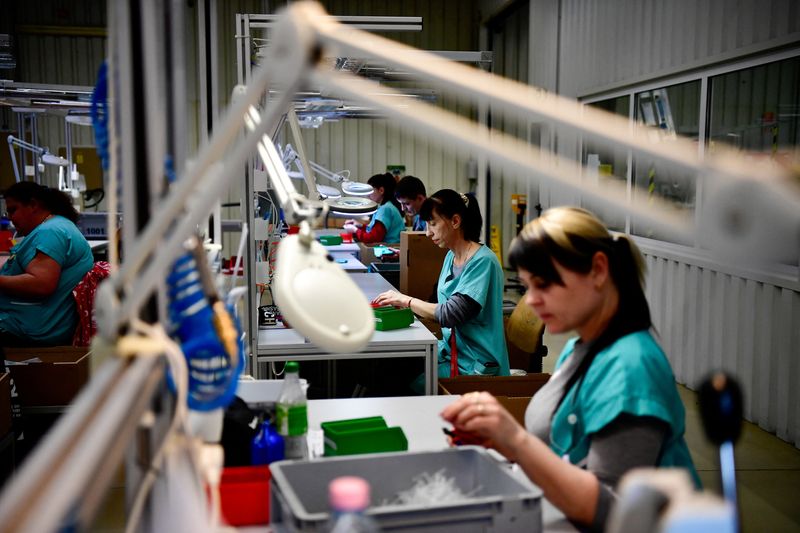
By Gergely Szakacs, Jason Hovet and Maria Martinez
BUDAPEST/PRAGUE (Reuters) - The sickly state of the German economy is the next big challenge for the export-reliant countries of central Europe, which are still recovering from some of the world's worst inflation spikes in the wake of the COVID-19 pandemic.
Close trade ties with Germany and its once-mighty auto sector were for years a boon for the region since the collapse of communism. But now those ties risk becoming a drag on the economies of Hungary, Czech Republic and Slovakia.
Already, some local companies reliant on ties with Germany are trying to tap deeper into other overseas markets and branch into industries like defence to mitigate the weakness of their large western neighbour, where another year of near-recession looms.
However such efforts come at a time of major geo-political uncertainties, with the Ukraine war, Middle East conflict and rising protectionism. Despite the push into the defence sector, all of these factors could hamper the efforts of the region's companies.
"Economic disruption in the region's most important trade partner, and persistent weakness in the auto sector, pose additional risks of economic setback to the CEE region," said Dawn Holland, Director, Economic Research at Moody's (NYSE:MCO) Analytics.
Central Europe's inflation surge, led by eye-watering levels at 25% in Hungary last year, has prompted central banks to lift borrowing costs to their highest in two decades, with Czechs enduring the most sustained fall in real wages, now spanning eight successive quarters.
German companies had annual turnover of some 250 billion euros ($270 billion) in central Europe in 2021, employing about 1 million people directly and many more through suppliers, according to Germany's Bundesbank.
The Czech Republic and Hungary rely on Germany for a third and a quarter of their exports respectively, with Slovakia sending a fifth of its exports there based on a tally by S&P Global. Poland is seen less exposed because of the strength of its more diversified domestic economy, with its exports less dependent on car manufacturing.
The best scenario for most companies interviewed by Reuters would be stagnation in turnover this year, though some did not rule out an outright decline in revenue and possible job cuts.
Building on feedback from clients, Hungary's DGA Gepgyarto es Automatizalasi Kft, which makes steel structures, welded components and custom manufactured machinery, had been planning a 50% capacity expansion to meet the expected growth in demand over three years from 2023 to 2025.
"This (higher) demand had evaporated," Tamas Tornai, Executive Director of the holding company that controls DGA told Reuters. Even so, DGA is going ahead with its 2.5 billion forint ($6.95 million) expansion to serve the booming defence industry.
WIPED OUT
Germany's car sector is not only struggling with weak sales in its U.S. and European markets but obstacles ranging from high energy prices to the global shift to e-mobility that is forcing a rethink of the future of internal combustion engines.
Within central Europe, Hungary has led a charge in attracting investments in battery and electric car manufacturing from China, positioning itself as a meeting point for Eastern and Western investors.
"There is a very strong decline in car sector demand, caused by inflation, interest rates and economic uncertainty, which nearly wiped out private buyers from the market," said Tamas Mogyorosi, Business Development Manager at Alap Group.
He said the company, which provides quality management and other services for car sector, aerospace and electronics industry clients, tried to make up for a decline in western European markets by ramping up orders from Asian clients.
Otto Danek, vice-chairman of the Czech Exporters' Association, said the sector has seen a sharp cooling since the second half of 2023 due to the weakness in Germany.
"A relatively small drop in demand from this territory has a significant impact on the entire export segment," said Danek, who owns Atas Elektromotory Nachod, a company making small electric motors.
"We are looking for new markets, more so in Europe ... but such a shortfall cannot be replaced in half a year."
Agrikon KAM, which makes components for agricultural machinery, serving mostly German clients, projects a 10% fall in revenue in 2024, which could lead to a 5% to 10% fall in its headcount by the middle of the year. It says a possible rise in sales to the U.S. will not fully offset the weakness in Europe.
Rating agencies say that weakness could complicate efforts to rein in budget deficits, which S&P Global says will remain "exceptionally wide" in historical terms for the region this year.
"The more protracted weakness in Germany is one of the top risks we see for CEE," said Karen Vartapetov, Director, Lead Analyst for CEE & CIS Sovereign Ratings at S&P Global.
"It could weigh on medium-term growth in CEE and further undermine what already appear to be challenging fiscal consolidation plans."
($1 = 0.9241 euros)
($1 = 359.56 forints)

